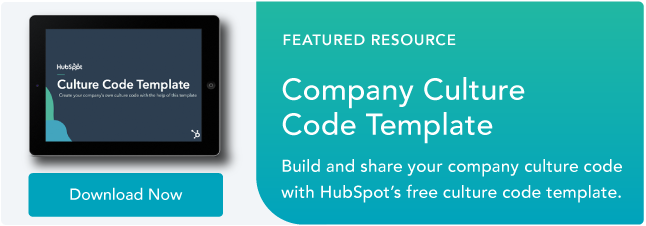To determine what causes employees to leave — and to create a better, happier employee experience moving forward — it's critical you conduct productive exit interviews.

In this post, you’ll learn everything you need to know about exit interviews, plus the best questions you should ask. We’ll also go over an exit interview form template that you can copy and paste into a document and reuse for future interviews.
Exit Interview
An exit interview is a conversation that happens between an HR rep and an employee when that employee quits the company. It consists of questions you ask the employee to determine ways you might mitigate turnover rates in the future.
What is the purpose of an exit interview?
The purpose of exit interviews is to get valuable insight from employees who are leaving your company. When conducted correctly, these interviews tell you what, if anything, could improve about your company culture. You’ll then be able to improve moving forward and drastically reduce employee turnover.
Why are exit interviews important?
According to a study conducted by The Society for Human Resource Management (SHRM), on average it costs a company between six to nine months of an employee's salary to locate and train a replacement for them. So if the employee who's leaving makes 60K, that can work out to anywhere between 30K and 45K in recruiting and training costs.
Undoubtedly, a high turnover rate can hurt your company financially. Additionally, a high turnover rate can lead to less productive teams, and lower employee morale overall.
Luckily, you can reduce turnover rate by using the feedback you get from exit interviews. Many employees who are leaving can help you determine areas for improvement and provide valuable feedback. Additionally, it can be helpful to identify consistent patterns of discontent to figure out larger organizational issues.
For instance, let's say you hire a new marketing director, and a year later, you see a severe increase in turnover rates. Out of 15 employees, only seven from the prior year remain. Undoubtedly, this change impacts your team's productivity and morale, and leave you nervous about the future of your department.
So how do you figure out what's going wrong, or how your marketing director can improve their performance to ensure higher job satisfaction for their team?
The answer is conducting an exit interview for every person who’s leaving. You’ll find out what your marketing director is doing wrong and help them improve in their leadership role.
You’ll also improve morale because you’ll show employees that you care about their experience. You’re not just letting people leave — you want to know why they’re leaving and stop anyone else from doing the same thing.
To ensure you're asking the right questions during exit interviews, take a look at the questions you should ask below and what to look for in an answer.
Exit Interview Questions
- How long have you been considering leaving our company?
- How did the job match expectations?
- What reason primarily describes your reason for leaving?
- If you have accepted a new position, what is most attractive about your new role?
- What did you like most about your job?
- What did you dislike about your job? What would you change about your job?
- How would you describe the culture of our company?
1. How long have you been considering leaving our company?
This is a simple question that will tell you whether this was a rash decision or a decision that happened over time. If it seems sudden, then it was likely caused by a certain event, and you’ll be able to better tailor your questions to get to the motive behind the employee’s decision.
What to Look For
Look for a time range. A year versus a month is a big difference. Determine whether any major company changes happened at the time they considered leaving — an acquisition, a change in management, and so forth.
2. How did the job match expectations?
The job may have perfectly met the employee’s expectations, or maybe it wasn’t exactly what they were looking for when they were thinking about the next step in their career. Regardless, this question will help you determine where you could be clearer in your job postings and in your company image.
What to Look For
Listen for “I thought I would be doing more of X” or “I was looking more of an X type of company.” This will help you better refine your job postings and the way you represent your business online. If an employee was looking to work at a startup and you’re an enterprise firm, you’ll want to screen future candidates for these expectations.
3. What reason primarily describes your reason for leaving?
Was it a change in lifestyle, a career change, or a better opportunity elsewhere? While the last option may seem like the most common and useful answer, a change in lifestyle — such as becoming a stay-at-home parent — could tell you where else you could improve.
For instance, you could offer paid parental leave so that your employees no longer have to choose between their jobs and their children. Or if they’re switching careers, you could offer more interdepartmental mobility to current employees, so they don’t feel stuck in one role.
What to Look For
Dig into the specific reason for their leaving without letting the employee dive into anecdotes or frustrations. Focus on what attracted them to the new opportunity, new career, or new lifestyle, and use those answers to figure out what you could offer your current employees.
4. If you have accepted a new position, what is most attractive about your new role?
This is a fantastic follow-up to the last question if the employee has already accepted an offer elsewhere. It also helps you dig further into what convinced them to leave the company and see where, if anywhere, you may fall short.
What to Look For
Listen for standard answers such as “pay,” “benefits,” “industry,” and “location.” Only note those that you can improve. For instance, you can’t really move offices or change your industry.
5. What did you like most about your job?
Give yourself a chance to breathe — and your employee, too — by focusing on the positives. That way, you don’t accidentally overhaul the things that work. If the employee answers that they loved the people they worked with, for instance, continue attracting top talent to your firm.
What to Look For
Listen specifically for the people aspect and the project management aspect of this answer. If the employee loved the projects they were working on or the people in their team, you’re doing the core things well. If they only mention surface-level things, such as the snacks or the free parking, you’ll want to revise your recruiting strategy.
6. What did you dislike about your job? What would you change about your job?
This is your opportunity to truly dig into what prompted the person to leave as it pertains to their role. Employees will likely “skirt around” the true reason here — or they may launch into an anecdote. Either way, listen carefully, and remember that this is only one employee’s experience. Only when you see repeated patterns do you need to take action, which is why it’s important to ask the same questions every time.
What to Look For
Search for answers that allude to the people in the team, because as the old saying goes, people don’t quit companies — they quit managers. If they don’t directly mention a person, listen for emotional words that show how the employee felt working in that team, which would show how the team operates under its manager.
7. How would you describe the culture of our company?
With this question, you can identify the gaps between your employees’ experience and the culture you aim to promote. Hopefully, you’ve already defined an organizational culture that upholds your values. (Pro tip: If you’re in need of inspiration, you can take a look at our Culture Code and steal some ideas from there.)
What to Look For
Don’t look for direct antonyms to what you’ve defined as your culture, because employees won’t be as up-front. They might use seemingly positive terms, such as “fast-paced” or “structured,” but these may hint at a high level of stress and a sensation of immobility. Listen carefully for these seemingly positive adjectives.
Don’t let it stop here. To ensure you’re employing best practices to get optimal feedback from your employees, take a look at our exit interview form template. It includes even more exit interview questions that will help you understand why the employee is leaving.
Exit Interview Form Template
Once an employee has given their resignation letter, you'll want to send them a form with some (or all) of the following questions. Give them time to submit their answers through the form before meeting with them to discuss their answers, face-to-face.
Below are some of the questions you'll want your exit interview form to include. Simply copy and paste them into your preferred word processor.
Exit Interview Form
1. How long have you been considering leaving our company?
2. How did the job match expectations?
3. What reason below primarily describes your reason for leaving?
a. New industry (significant career change)
b. Compensation
c. More opportunities for learning and growth
d. Personal Reasons
e. Manager / leadership quality
f. Day-to-day work environment / culture
4. If you have accepted a new position, please select all the items that are more attractive about your new role:
a. Better pay
b. Better culture
c. Better location / commute
d. Different industry
e. Manager
f. Better work-life balance
g. More career advancement opportunities
5. What did you like most about your job?
6. What did you dislike about your job? What would you change about your job?
7. How would you describe the culture of our company?
8. How would you describe the general atmosphere in the office?
9. The quality of supervision is important to most people at work. How was your relationship with your manager?
10. What could your supervisor do to improve their management style and skill?
11. We try to be an employee-oriented company in which employees experience positive morale and motivation. What is your experience of employee morale and motivation in the company?
12. Please provide any context to further describe your reasons for leaving. Was there an event that led to this decision?
13. What were your reasons for joining our company originally? How have your feelings changed?
14. Do you believe your manager supported your professional development?
15. What are 1-2 things our company could do to promote a better workplace?
16. Please provide context and any additional feedback you’d like to provide on your manager.
How to Conduct an Exit Interview
Now that it’s time to conduct the interview, you’ll want to take the following steps to make sure the conversation is productive, amicable, and neutral.
1. Send the exit interview form to the soon-to-be ex-employee.
First, send the person who is leaving a form or document with your standard questions. This would happen the same week that they put in their resignation letter — ideally within one to two days. They should already know a form is coming their way, because you would have expressed that verbally.
2. Choose an interviewer and set up the meeting.
After you've given the employee time to thoughtfully respond, it’s time to choose an interviewer and set up an in-person meeting.
The interviewer should be an unbiased third party, such as a staff member from your HR team. Don’t set up the exit interview meeting with their manager or with anyone whom the person has worked with before. This may impair their ability to be honest during the interview.
3. Ask the same questions in every exit interview.
Ensure you ask the same questions in each exit interview so you can gather actionable data and insights.
Prepare a handout for yourself that prompts you to jot down similar notes for every person you or your HR staff member interviews. If all of the notes are highly disparate or seemingly disconnected, it will be difficult to glean insights and improve moving forward.
4. Keep the tone of the conversation neutral.
In person, do not ask targeted questions regarding specific people or departments — keep your questions general and don't input your own opinion into the conversation. Don’t prompt the employee to over-share about their frustrations with the job.
This is not constructive to you as a company. Rather, you want to find out areas of improvement in more general terms, so that you can create company-wide change.
If the employee only gives personal anecdotes, that would only help you create a better experience for them. The problem is that they’re already leaving. What you want to find out is how you can improve the employee experience for those who are staying.
5. Distill the answers into insights.
Identify patterns you see from different exit interviews, and use that data to draw conclusions on which feedback you should use to improve the employee experience moving forward. As mentioned, take similar notes for each exit interview. To make it easier, you could use a survey software that helps you collect the employee’s written answers.
Exit Interview Best Practices
Ultimately, an exit interview doesn't just help you understand why your talent is leaving — it also helps you ensure you can implement strategies or cultural changes to improve the satisfaction of employees who stay.
However, it's not always easy to discern what a highly productive exit interview looks like.
To learn more about exit interview best practices, I spoke with Winston Tuggle, an HR Business Partner at HubSpot. Here are some of the best practices he suggests.
1. Always ask the same questions.
When it comes to exit interview best practices, Tuggle suggests, "For conducting productive exit interviews, I think one key is asking the same questions of all people who leave. This structure allows us to codify the exit responses so we can extract actionable data around why people are leaving, and how we can improve the employee experience.
We do this by having a standard exit interview form that leavers submit, and then have an unbiased third-party follow up in-person to go deeper on the answers the person filled out in the exit interview. Exit interviews aren't necessary unless you plan on using them to gather as much data as possible that can be coupled with employee survey data to understand the employee experience."
2. Understand the “why” behind the person’s resignation.
Tuggle also notes, "[It's critical you understand] the 'why' behind someone leaving ... to gather trends over time. As an HR team, it helps us to not overreact to one person's experience and conversely helps us identify trends that we can proactively address before they lead to more unwanted attrition."
3. Explain the purpose behind the exit interview.
It's important you explain the purpose behind the exit interview to each employee before you begin. You might say, "We hope to use your feedback to continuously improve our culture and business processes, so we are interested in your honest opinion on how your experience has been." That way, they don’t feel they’re taking part in a conversation that won’t be used to create change.
4. Ensure interviews stay confidential.
You'll also want to make sure your exit interviews are confidential between the HR team and employees. While data or general insights can be used to improve employee experience and should be shared with leadership, your employee needs to know their exact complaints won't reach their old manager or coworkers.
5. Thank the employee for their time.
Finally, be sure to thank your employee for taking the time to provide feedback during an exit interview. While one individual likely can't pinpoint issues regarding an entire team or department, you'll likely see commonalities over time that can help you determine how you can improve your workplace for the long-run.
Exit Interviews Will Improve Your Company Culture
Exit interviews are the key for improving your business from the inside out. Knowing what makes some employees leave can help you keep the employees you already have. As a result, you’ll improve your company culture, reduce turnover, and boost productivity — leading to a better and better workplace over time.
Editor's note: This post was originally published in January 2019 and has been updated for comprehensiveness.











